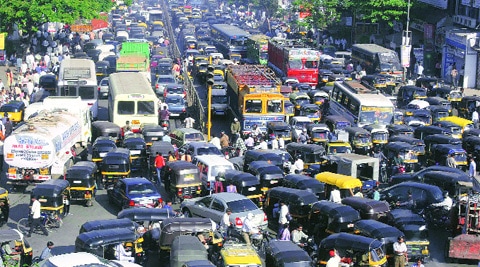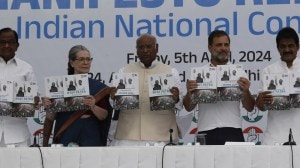- India
- International
Chaos rules the city roads
In a city that sees over 50,000 cars added each year on its roads, even a 15-minute roadblock due to shortage of parking space can lead to huge traffic snarls.
 Haphazard and illegal parking often leads to huge traffic snarls on Mumbai’s roads, which last for hours.
Haphazard and illegal parking often leads to huge traffic snarls on Mumbai’s roads, which last for hours.
With capacity to accommodate parking for barely 15 per cent of the number of four-wheelers registered in the city, illegal parking on footpaths and roads have led to deaths of pedestrians and disrupted traffic movements in the city. Parking problems, identified as a prime concern by the Mumbai traffic police, are set to worsen over the next two years if unchecked. MEGHA SOOD, ALISON SALDANHA and MAYURA JANWALKAR take a look at the parking issues plaguing the city and the road ahead.
When the proposal to accommodate 19,000 underprivileged children being brought to watch the Indian Premier League season 7 match between Mumbai Indians and Kings XI Punjab on May 4 was conveyed to the Mumbai traffic police, their first and only concern was transportation and parking of vehicles.
An hour after the children had stepped out of 450 Brihanmumbai Electric Supply and Transport (BEST) buses and walked into Wankhede Stadium on the day of the match, it became clear it was far easier to park public transport vehicles, as compared to the 1,500 private cars that arrived at the stadium that afternoon. Just before the match began, the traffic police were hard put to free up the surrounding arterial roads.
In a city that sees over 50,000 cars added each year on its roads, even a 15-minute roadblock due to shortage of parking space can lead to huge traffic snarls.
“On that day too, we had made arrangements, but were still left in a crisis. We had made parking arrangements for over 50 buses at Colaba bus depot and at a few other spots around the stadium. Managing these buses proved to be easier than parking the private cars. One bus carried spectators which would have otherwise arrived in 40 cars,” said B K Upadhyay, Joint Commissioner of Police (Traffic). “The situation would be manageable if public transport is preferred by residents. A good public transport system should be in place to solve the problem of decreasing parking space in the city,” he added.

To deal with the menace of illegal parking, the traffic police conducted a road audit in February this year, identifying 200 trouble spots that led to traffic logjams, some extending to a few hours during peak traffic. At some places, private school buses proved to be a problem. At other junctions, heavy vehicles remained parked for over a day. A drive was subsequently started to check illegal parking on roads, especially those that see traffic all through the day.
“We are still to make the drive strict since we understand the problems of the drivers. In the end, it’s space crunch,” Upadhyay said.
In 2013, around 21 pedestrians lost their lives and 168 were seriously injured in road accidents. “Almost 40 per cent of these accidents occurred when pedestrians were walking on the road instead of the footpath. In each of these cases, there was a car parked on the footpath,” the traffic police chief said.
Police also found that almost 80 per cent of the roads in the city are double-lane. However, in most of them, one lane has been taken over by cars that have been parked, leaving just one lane for vehicular traffic.
According to the Mumbai Development Plan (2014-2034) preparatory report, private vehicle ownership in Mumbai increased from 52 per 1,000 persons to 82 per 1,000 between 1996 and 2005. The civic body estimates the rise will double at 197 per 1,000 persons by 2031.
“Currently, roads and footpaths are used for parking cars rather than for commuting and walking. Of the total population of 1.2 crore in the city, it is estimated that only 20 per cent depend on private transport. The rest use either public transport (buses/trains) or intermediate public transport (rickshaws/taxis). Yet, this 20 per cent of the population uses 90 per cent of the city’s open spaces for parking,” additional municipal commissioner S V R Srinivas said.
In eight meetings held between June 2012 and February 2013, an 11-member committee appointed by the Bombay High Court had identified 35 traffic problems in the city. The problem of haphazard parking leading to traffic snarls, according to the committee’s report submitted to the High Court following a PIL filed by the Bombay Bar Association, was caused to a great extent by the availability of free or cheap parking.
The report stated that compared to cities like Hong Kong, New York and Bangkok, parking in Indian cities was much cheaper. “In Hong Kong and New York, pricing is market-driven, with monthly parking rates for a reserved parking space ranging from Rs 10,000 to Rs 20,000. As a result, the car ownership in such vertical cities is much lower than what the purchasing power of the people in these cities would warrant,” it stated.
In Mumbai, the report said, there is ample free parking on the road and parking charges levied by the BMC is as low as Rs 5 to Rs 20 per hour. With an annual addition of 50,000 cars, besides two-wheelers, water-tankers, school buses and commercial vehicles, the demand for parking space would escalate each year.
“The effect is clear and visible. Most of these vehicles land up on roads for parking in an unregulated manner. The situation is getting alarming,” the report had stated.
According to the High Court-appointed committee, there were over 1,500 school buses and as many private buses running in the city. These buses were parked on streets or by the roadside, thus impacting the flow of traffic and causing gridlocks. The BEST bus fleet had, as per a report in 2013, increased from 3,500 to 4,500, but the public utility had not been able to get more land for depots and terminals necessary for night parking, maintenance and upkeep of these buses.
CITY’S PARKING CAPACITY
Currently, the civic body manages 92 public parking lots that have a total capacity of 11,000 vehicles. “In addition to these, there are an additional 36 parking lots for public use at the ward-level in the 24 administrative wards of the city,” said a senior civic official of the civic traffic department.
In a city starved of space, parking is not the first priority, according to planners. In the few public parking projects that get sanctioned, delivery of the projects to the BMC have been delayed by builders. The public-private-parking-lot (PPPL) scheme was introduced in 2008 as part of the Development Control Rules for Mumbai, under section 33 (24). According to the policy, a PPPL measuring over 700 square metres of built-up area can be constructed in a minimum plot size of 1,000 square metres in the island city or 2,000 square metres in the suburbs. The multi-storey parking lots must accommodate at least 50 cars.
In the policy, builders constructing these parking lots for free are given an incentive of additional 40 per cent Floor Space Index (FSI). Those who construct these lots near high footfall areas such as railway stations, government offices and religious or tourists spots are granted an FSI incentive of 50 per cent more (subject to the cap of an FSI of 4 for island city and 3 for suburbs).
After a series of meetings, the civic body, in 2012-2013, approved 32 proposed PPPLs, of which 26 have received letters of intent (LOI) while 11 have even received commencement certificates (CC) from the corporation. Once ready, these parking lots are expected to make space for 30,000 more vehicles.
So far, under the scheme, the civic body has managed to open just one PPPL at Apollo Mills, Mahalakhshmi, which was thrown open for public use in 2013. The five-level parking lot includes basement and lower basement.
Two PPPLs – one at Times Square at Sakinaka and the other at Topiwala Cinema in Goregaon – are almost ready for possession, but the civic body has yet to assume control of these.
“We take over the lots when the builders tell us they are ready for possession. Until these projects are fully completed and ready for operation, we cannot take over,” said R A Pawar, chief engineer of the roads, bridges and traffic department of the BMC.
As per the amended rules, construction of only up to four floors is allowed with two underground levels. The rules also state that a maximum area of 50 sqm should be reserved for LMVs (low moving vehicles such as cars) while a maximum 80 sqm area should be kept for HMVs (high moving vehicles) in a parking lot.
In December 2013, the Bombay High Court dismissed a petition challenging the Mumbai Metropolitan Regional Development Authority’s (MMRDA) decision to take back three plots of land licensed to the Bombay Goods Transport Association (BGTA) for construction of a truck terminal in Wadala (East). On September 2, 1998, the BGTA was handed over three out of 12 plots sprawling over 61.51 hectares that was allotted to the MMRDA by the state government for the construction of a truck terminal. The decision was aimed at de-congesting traffic in south Mumbai and end illegal parking of trucks on roads. The proposed truck terminal would accommodate about 4,000 trucks at a time. On August 17, 2012, the MMRDA passed an order taking back the possession of the three plots, saying the BGTA had failed to submit their construction proposal.
THE ROAD AHEAD
To discourage parking on roads, the civic body this year has sought to charge motorists on the basis of corresponding land rates in a particular area, timings of parking and so on. In popular parking areas, the BMC has proposed a 300 per cent hike in parking rates, from Rs 20 to Rs 60 per hour.
“We have come out with a new policy that will help regulate parking and bring some order to the current chaos. The policy have received in-principle approval from the group leaders and the civic improvements committee. Now the civic general body must give its final approval before we can begin implementation. Corporators have been generally opposed to the parking policy because of the steep hike in charges, but this will be necessary as we believe this can be a deterrent for using private cars and may encourage use of public transport,” a senior civic official of the traffic department said.
The administration has also suggested more parking fees for truck owners and private cars while recommending a lower charge for on-duty taxis. Charges will also differ for peak and non-peak hours, with a lesser amount levied on holidays. In a bid to ease congestion near schools and colleges, the policy have also proposed to remove parking lots located within 100 metres of such institutions.
Defending the hike, Additional Municipal Commissioner Srinivas said, “There is a problem with the demand and supply when it comes to parking space in Mumbai. The supply of space is inelastic and the only way we can control the demand is if we raise the parking charges.”
The corporation has also planned to hand out parking permits for residents to park their cars on one side of the road. These will be annual permits for specific road spots that bars other cars from parking there.
In addition, the traffic police have launched a crackdown on angular parking on roads. “Parallel parking takes lesser space compared to angular parking as the car’s body juts onto the second lane. We have instructed all the constables to take action against drivers of such cars,” Upadhyay said.
The problem has become so acute that the traffic police have even written to the authorities concerned asking for a check registration of new cars. “If it continues on the same pace, it would be difficult to accommodate even 10 per cent of vehicles in the next two years,” Upadhyay said.
The department has already begun talks on this with the Regional Transport Department.
Another suggestion, currently on the backburner, is the proposal for car-pooling. “A way to do it is to penalize the driver for having less than three passengers in one car. Besides, various agencies should come forward to make car-pooling easily available for people,” says a traffic police official.
In March 2013, the high-powered committee appointed by the Bombay High Court had submitted 51 suggestions to the court for addressing the city’s traffic woes. These included a congestion charge to restrict the number of vehicles in certain areas, including the city’s central business districts, and congestion pricing on certain goods in select zones. The committee suggested a two-to-three-year time-frame for the introduction of congestion charges.
The panel has also recommended the imposition of “a sizeable cess on the consumption of petrol and diesel for cars in Mumbai city or the metropolitan region and utilizing the proceeds for the improvement and strengthening of the public transport system”.
The committee had mooted the establishment of a comprehensive parking unit for the city to look at on road/off road and vertical parking. “The MCGM (the civic body) has invited expression of interest for implementing ‘web-based parking’ for on-street parking, which involves electronic hand-held devices capable of issuing e-challans of parking fees, taking photographs of vehicles, noting vehicles’ registration numbers and transferring and storing all data to a central server of MCGM. These devices can also be later extended to use smart cards in future,” said the report.
As a stop-gap measure, the traffic police also experimented with using space below flyovers. However, they found multiple entrances and exits below flyovers only created additional traffic jams.
megha.sood@expressindia.com
alison.saldanha@expressindia.com
mayura.janwalkar@expressindia.com
Apr 25: Latest News
- 01
- 02
- 03
- 04
- 05








































